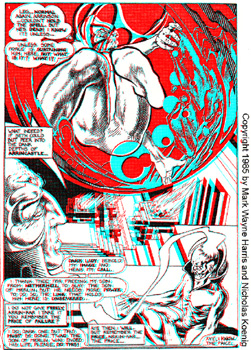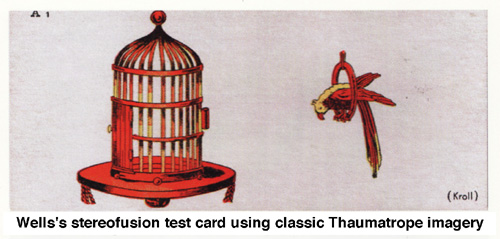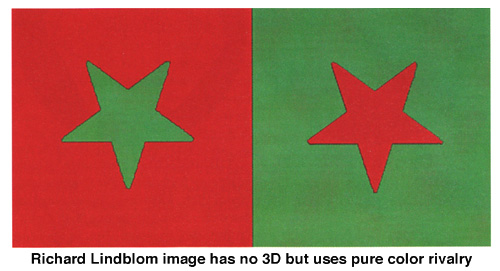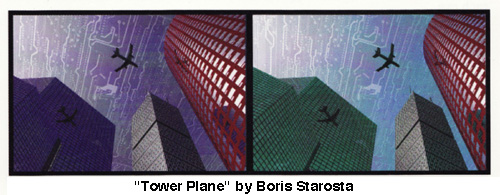


Though he provides no explanation, Arthur Judge includes an image titled "Stereogram of a Crystal Showing Iridescent Effect" in his landmark book, Stereoscopic Photography from 1926. The image makes a striking use of "retinal rivalry." As the brain creates stereo fusion of the two "half-fields" of the visual pair, real depth in the crystal becomes apparent. But, at the same time, the juxtaposition of black and white produces an interesting kinetic effect that Judge characterizes as "iridescent." This glimmering effect in the image is a result of the brain's attempt to reconcile the conflicting information presented to each eye.
The "Crystal Stereogram" is a great example of the two primary theories of binocular stereopsis, fusion and suppression. "We will take the term 'fusion' to mean that similar images presented to the two eyes appear as one and are processed simultaneously rather than successively," write Ian P. Howard and Brian J. Rogers in their landmark study Binocular Vision and Stereopsis (Oxford University Press: 1995). "According to the 'suppression' theory, both similar and dissimilar images from the two eyes engage in alternating suppression at a low level of visual processing."
With "binocular rivalry," Howard and Rogers state that "the two images compete for access to higher levels of visual processing by a process of alternating inhibition." This might account for the kinetic effect, the impression that is something like a neon sign blinking on and off.
For the last century, optometrists and ophthalmalogists have used, and continue to use, the stereoscope as a tool for diagnosis of visual dysfunction. Different publishers, including Keystone, have issued stereoview cards that have made imaginative use of retinal rivalry as a means of determining stereo deficiencies in children and adults alike.

One of the earliest sets was "Dr. Wells' Selection of Stereoscopic Charts," published by American Optical Company and consisting of 49 black and white and 21 colored plates "for cultivating binocular vision and for treatment of heterophoria." The first card in the series, displaying a bird in the right eye and a cage in the left eye, is actually an image that was first devised by John Ayrton Paris in 1825 as a toy to demonstrate persistence of vision, the active principle behind motion pictures. Paris's "Thaumatrope" consisted of a disk attached to two strings with the two images printed on opposite sides of the disk. When the disk was rapidly spun by pulling on the strings, persistence of vision made the bird appear to be in the cage.
The Wells' set proved highly useful to optometrists. Dr. David W. Wells was also the author of a companion volume, The Stereoscope in Ophthalmology, published by Globe Optical Company in four different editions from 1912 to 1928. By 1933, the Wells' set had been published in twenty-six editions. Similarly, the "Stereoscopic Charts" by G.P. Guibor, available in a boxed set dated 1936, featured 14 test charts (stereo pairs) and 66 "split" cards that could fit together in different combinations for the left and right eyes separately and binocular viewing in the stereoscope. Guibor wrote that the 14 stereo test charts were "for diagnosis of subjective phenomena" and that "split charts" were for "fusion training." A unique set of "Animated Fusion Training Charts" by Israel Dvorine, available in a boxed set dated 1951, could be used with any "hand stereoscope." This "diagnostic set of charts" featured a wheel that rotated visual elements for one eye and were "for the measurement of lateral and vertical fusion amplitudes" in the "treatment of strabismus and other visual imbalances."

Some of the most unique stereo photographs using retinal rivalry were made by Joseph Jastrow, the first professor of psychology at the University of Wisconsin from 1888 to 1927 and one of the founders of the American Psychological Association. The photos were made on glass plate negatives and were made prior to 1905, the year when the Underwood & Underwood Company acquired them. By the 1920s the Keystone View Company purchased the Underwood Library and Jastrow's photographs are archived today with the Keystone-Mast Collection at the California Museum of Photography (CMP). Jastrow was interested in optical illusion and the structure of belief. He isolated perceptual cues in a photograph to create illusions that were disproved when viewed in stereo. The parallax disparities in a stereo photograph, Jastrow wrote, "prove conclusively that the difference in the retinal images is the prime factor and that all others form accessory methods for the inference of depth." One of Jastrow's most poetic images juxtaposes "Ideal Beauty" in the form of a classical sculpture, seen in the left eye, with the image of a real Victorian woman in the right eye. Standing small in the background, a male with his back to us assumes three-dimensional reality.
In a CMP monograph titled Professor Jastrow's Three-Dimensional Illusions, Edward Earle, Curator of the Keystone-Mast Collection writes about this view that "The woman becomes a mere transparency, with the classical ideal shining through." In creating stereoscopic images stripped of two-dimensional depth cues, Jastrow's work foreshadowed the experiments of Bela Julesz, inventor of the Random Dot Stereogram and author of Foundations of Cyclopean Vision (Chicago: University of Chicago Press. 1971).
Retinal rivalry has also been used for its artistic effect throughout the history of stereography. Numerous tissue views made use of an image that appeared in only one eye when the stereo view was held up to the light. Color litho cards were also occasionally printed with opposing tints, red or blue, in left and right halves of the stereo view card.

In the 1980s, perceptual psychologist and stereographer Richard Lindblom made a series of paintings that explored both 3-D imaging and retinal rivalry. Lindblom made a series of paintings with "color rivalry" in which complementary colors such as red and green were juxtaposed between the left and right eye images. The penultimate Lindblom image depicts a red star in a green field for the right eye and, perfectly superimposed, a green star in a red field for the left eye. When seen with stereoscopic projection, or in a hand viewer, the star seems to actively flicker as the brain attempts to resolve the complementary colors.

In 2001, fine art stereographer Boris Starosta created an intriguing computer generated (CG) stereoview titled "Tower Plane" depicting a jet flying between urban buildings. The sky and a building in one half of the stereo view is tinted blue and in the other half magenta. The color rivalry is only minimally disturbing, but the view is a remarkable evocation of the World Trade Center disaster and the retinal rivalry underscores the shock to the psyche that the event represents.

When I discovered the binocular experiments of Wells, Jastrow and Lindblom, I resolved to use retinal rivalry in some of my 3-D comics work. I found a perfect opportunity in 1985 with the Merlin Realm In 3-D comic book issued by Blackthorne Publishing. Converting the art by Nicholas Koenig to 3-D for page 23 of the magical tale, I juxtaposed black and white elements within an imprisoning mystic globe encircling a magician. Here, I felt, was a perfect image for retinal rivalry.
In reviewing the different theories, Howard and Rogers conclude that "the actual processes underlying binocular vision are more complex than either the fusion theory or suppression theory suggest." The glimmering binocular effects of colors and shapes in retinal conflict remain a fruitful and provocative area of exploration for any artist creating work to be seen with two eyes wide open.
Ceram, C.W. Archaeology of the Cinema. New York: Harcourt Brace & World, Inc. (no date)
Earle, Edward W. Professor Jastrow's Three-Dimensional Illusions. CMP Bulletin, Volume 4, Number 2. Riverside: California Museum of Photography. 1985.
Howard, Ian P. and Rogers, Brian J. Binocular Vision and Stereopsis. New York: Oxford University Press. 1995.
Judge, Arthur W. Stereoscopic Photography, Its Application to Science, Industry and Education. Boston: American Photographic Publishing Co. 1926.
